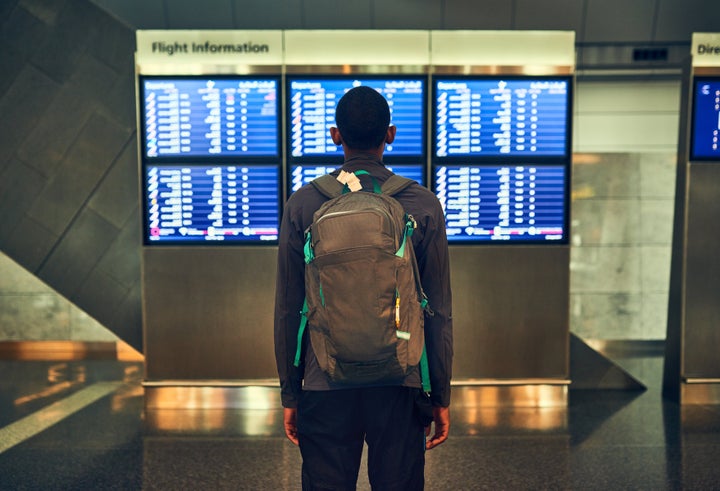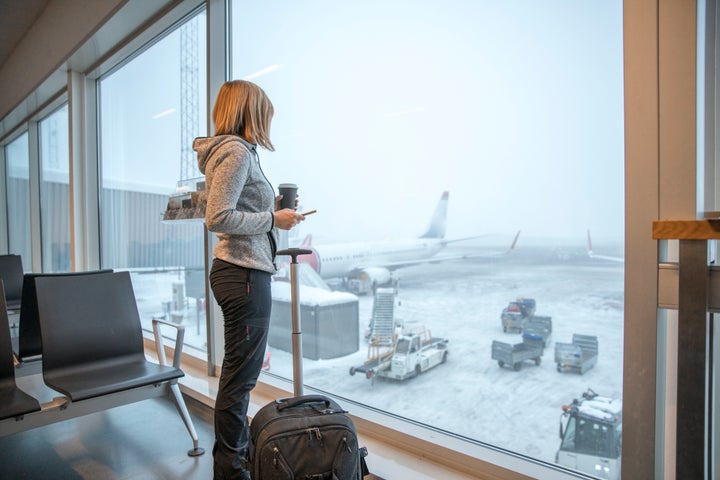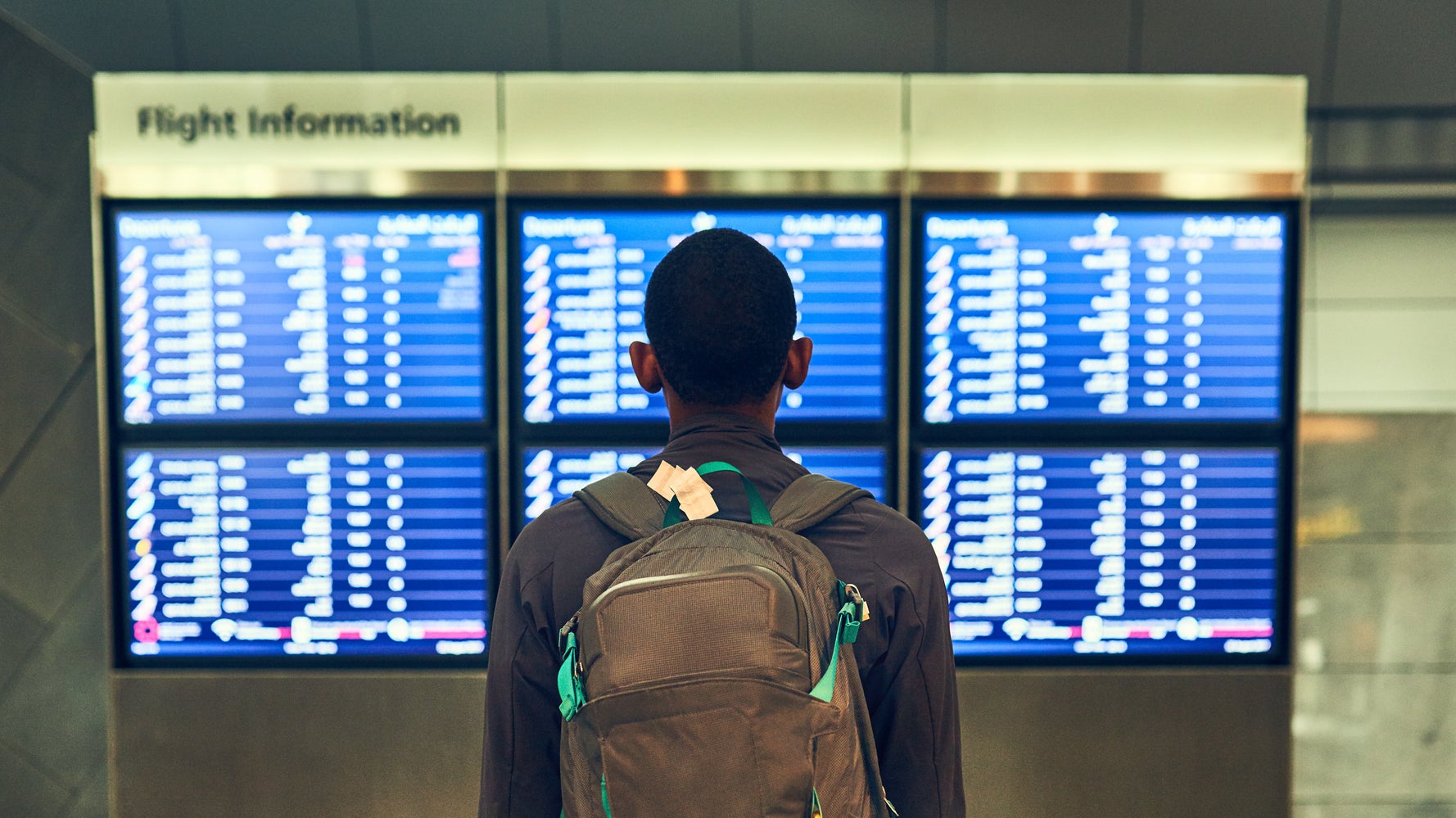
Flight delays are inevitable, but they can be incredibly frustrating.
If you don’t fly very often, you might think the situation is completely out of your hands, and you’ll wind up stewing in annoyance and uncertainty. But there are ways to reduce your risk of facing a flight delay or, at the very least, know when they’re coming, to make the experience less stressful.
We asked travel experts to share what many inexperienced passengers don’t know about flight delays and their advice for understanding the process. After all, knowledge is power.
You can track your airplane.
It’s useful to download the mobile app for the airline you’re flying to get notifications about gate changes and delays before they even get announced on the screen at the airport. But you can also use it to follow your plane’s journey ahead of its arrival at your airport and anticipate potential delays to your flight.
“In the app for your airline, you can often see specifically where the plane is coming from and if it is arriving on time,” said Ravi Roth, queer travel expert and “Gaycation Travel Show” host.
There are also a number of non-airline apps and websites that allow you to keep tabs on your flight and previous departures. All you need is your flight number, the airline and the departure date.
“FlightAware and Flightradar are two of my favorites, and you are able to track where your flight came from and also where it is in that moment, which I think is so fun to be able to see your plane in real time,” said travel blogger Esther Susag. “Also, just simply checking the published flight status of the plane via a simple Google search can also be much more informative than you think.”
Earlier flights are less likely to get delayed.
“Later flights, which are relying on crew and potentially the plane itself from a prior segment, are more susceptible to be delayed,” said Adit Damodaran, an economist at the travel booking app Hopper. “In other words, an early flight getting delayed can have a ‘ripple effect’ in which subsequent flights are also delayed. We recommend always booking the first flight out if you can to avoid any impact of delays from earlier in the day.”
So if you hate flight delays more than you hate waking up at the crack of dawn, opt for a morning flight. Being able to track your plane can also be reassuring when you have a morning flight.
“If I wanted to fly from D.C. to Chicago tomorrow, I could book a 6:45 a.m. flight from Dulles and see that the plane will arrive from Los Angeles at 12:45 a.m.,” said Willis Orlando, senior product operations specialist at Scott’s Cheap Flights. “The plane is scheduled to arrive six hours before my flight, so even if there are mass delays, that plane ― or at least a plane ― will be there for me in the morning. Whereas, if I decided on a 1 p.m. flight, my plane would be arriving only an hour beforehand, and the odds increase that there might be a delay due to weather issues, staffing issues, mechanical issues.”
Of course, morning flights aren’t immune to delays and other problems. But even if something does happen with your morning flight or it ends up getting canceled, you’ll typically have many more options for getting to your destination on the same day ― whereas a canceled flight in the late afternoon or evening often means having to go home or to a hotel and return to the airport the following day.
Flying nonstop also offers better odds.
In addition to booking a morning flight, you can also try to avoid delays by opting for nonstop when possible.
“Obviously you lower your odds of being delayed by flying nonstop because there are fewer flights involved,” Orlando said.
The nonstop option can cost more money, but you don’t have to go to as many airports and gates. You can also avoid worrying about missing the connection if your first flight is delayed. If you crave that peace of mind and can’t stand delays, paying a little extra might be worth it.
That being said, nonstop isn’t always an option. In those cases, you can be strategic about your layover choices with timing and location. Aim to give yourself at least an hour between flights. You should also try to connect through a city that has many flights to your final destination.
“Choose a route that’s offered several times in the day,” Orlando advised. “That way your chances of getting rebooked on another flight quickly are better.”

Paying attention to weather patterns can help.
Another way to stay on top of flight delays is to think about weather. This also plays into your choice of flight connections.
“If you’re flying cross-country on a major U.S. airline and have to make a stop, they have hubs in both warm and cold places,” Orlando explained. “So with United, you could connect through Chicago or Houston. The wise choice would be Houston in the winter to avoid the snow in Chicago and Chicago in the summer to avoid potential tropical storms in Houston.”
As your trip approaches, you might want to pay attention to weather patterns at your departure and arrival airports and along the flight route. Being aware of bad storms ahead of time can help you anticipate potential delays, especially around the holidays, when winter storms are a concern.
Weather issues in other parts of the country can also have a cascading effect on flights across the U.S., including places that aren’t directly affected. And, of course, weather isn’t the only cause for delays.
“Keep in mind that even in clear weather conditions, airlines can still face delays and cancellations as a result of disruptions to incoming flights, staffing issues, technical issues or other unforeseen circumstances, so don’t let clear skies stop you from being vigilant,” said Jen Moyse, senior director of product at TripIt.
You can check the on-time percentage for your flight when you book.
Federal regulations require airlines to share the on-time flight performance data on their websites. So when you’re scheduling your travel, you can usually see how frequently a given flight arrives on time. Understandably, you might want to opt for one with a higher on-time percentage.
If you can’t easily find that data on the airline’s website, there are other places that publish this information, including FlightAware and FlightStats.
The U.S. Bureau of Transportation Statistics website also offers statistics on airline and airport delays to give you a better picture before you purchase your ticket.
It’s important to know your rights.
Even if air travel makes you feel like a herded cow, you actually do have rights as a passenger. The Department of Transportation website outlines your rights during a delay at the airport or on the tarmac.
“Luckily there are rules tied to tarmac delays, or passengers stuck in a plane waiting on the tarmac,” Moyse said. “Airplanes are required to allow passengers to leave an outbound or inbound plane after three hours for domestic flights, and four for international.”
Passengers are also entitled to up-to-date information about their delays from the airline, so don’t hesitate to inquire about what’s going on if you feel it’s been a while since you heard an update.
You might be entitled to money.
“When I think about flight delays and common mistakes people make, I think about how many times people miss out on the chance to get money back or compensated,” Susag said. “Always, always look at the airline terms and conditions, because most of the time you can always find a way to get a large chunk of what you paid for back when your flight is delayed.”
Indeed, eligible passengers traveling in the European Union can be entitled to compensation for flights delayed three hours or more. Your travel insurance plan could also include compensation for delays of a certain duration, so check the fine print.
Susag also noted that airlines are obligated to give your refund in money rather than in miles or a credit with the carrier, so ask for cash if you prefer that option. Depending on the circumstances, airlines can also be obliged to cover expenses incurred due to delays or cancellations (like food and hotel accommodations).
Additionally, some travel rewards credit cards include trip delay protection, so you could get reimbursed for expenses that the airline won’t cover. If you booked your trip through a third-party travel planner, pay attention to the plan you chose. Apps like Hopper offer plans with compensation or free rebooking options for flights delayed more than one hour, for example.
Delays happen. Build in a buffer for important trips and don’t take it out on airport workers.
Sometimes travel stakes are high. You might be flying to your wedding weekend or trying to make it home for the holidays for the first time in years. In these instances, it’s helpful to build in a buffer to avoid having a delay derail your plans.
“Try to bake some flexibility into your schedule if you can, especially for Christmas and New Year’s holidays coming up,” Damodaran said. “It’s always a good idea to buffer an extra day or so, in case there are disruptions to your trip, to ensure you can make it in time for any holiday festivities.”
Delays are normal, especially in peak travel season. The days just before Christmas and New Year’s Eve are some of the busiest of the year, and the air travel industry is still recovering from staffing shortages.
“It’s been an unusual year for travel with flight disruptions and changing COVID-19 restrictions,” Moyse noted. “This has led to many heated interactions at the airport and on planes, and a rise in unruly passengers, which have impacted the overall travel experience.”
Whatever happens with your flights, taking out your frustration on airport workers will probably not make the experience more pleasant.
“Patience is key to managing the ups and downs of travel, as it will always be a little stressful to navigate schedules and crowds,” Moyse said. “Prepare for potential disruptions and pack a smile.”
